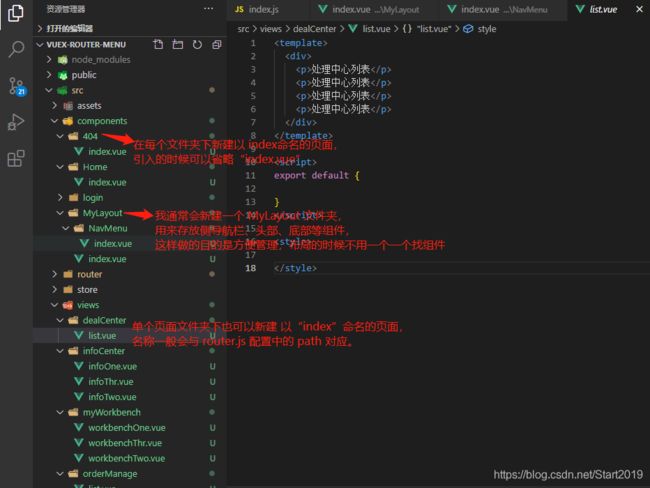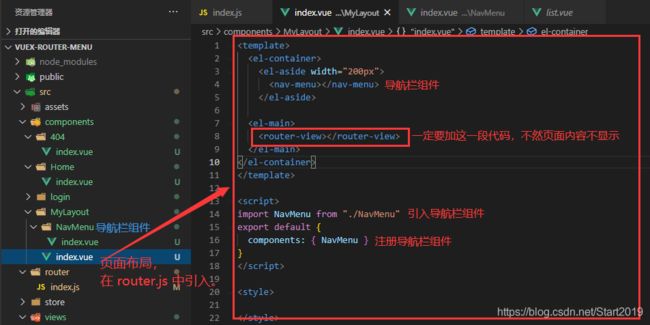手把手教你用 elementUI 实现导航栏
elementUI导航栏官网
1. 安装 elementUI
2. 文件准备
3. 配置路由
4. 导航栏代码
一、安装 elementUI
-
npm i element-ui -S; -
在 main.js 中注册组件:
import ElementUI from 'element-ui';
import 'element-ui/lib/theme-chalk/index.css';
Vue.use(ElementUI);
- app.vue 也有在外面套了一层
<template>
<div id="app">
<router-view/>
div>
template>
二、文件准备
要做如下左边的导航栏,我们首先要有对应的文件夹和文件来存放与导航栏对应的页面,还要一个专门写导航栏的组件页。
在 vue-cli3 中,页面都是存放在 views 中,组件仍然放在 components 中。具体如下:

三、配置路由
1. 捕获所有路由或 404 Not found 路由;
2. 解决重复点击同一导航时报错问题参考执着菜鸟一颗心;
3. 配置路由中的用到的字段:
hidden:false 表示不隐藏,会在导航栏中展示;true 表示隐藏,在导航栏中不会显示出来。leaf:false 表示多个节点,有子菜单;true 表示只有一个节点,单个菜单。- 注意:
name最好不用用中文,在meta中写自己需要的字段。
我在项目中路由配置是这样的:
import Vue from 'vue'
import VueRouter from 'vue-router'
import MyLayout from '@/components/MyLayout'
import notFound from '@/components/404'
Vue.use(VueRouter)
const routes = [
//当 Home 页是个独立的页面,与导航栏中的页面都不相关时,
//直接用 comonent 引入Home组件,记得要 import。
// {
// path: '/',
// name: 'Home',
// meta: { hidden: true },
// component: Home
// },
{
//这里列举的是 Home 页也是“处理中心”的列表页,用 redirect 重定向到配置“处理中心”的 path 上去
path: '/',
name: 'Home',
meta: {
hidden: true },
redirect: "/dealCenter"
},
//因为导航到的每个页面,都包含了导航栏、头部、底部、主体部分(统一到MyLayout组件中)
//所以我每个菜单都会让根菜单component: MyLayout,再用 redirect 找到原本component的主体页面。(有多个子菜单的 redirect 可以省略)
{
path: '/dealCenter',
name: 'dealCenter',
component: MyLayout,
redirect: "/dealCenter/list",
meta:{
title: "处理中心",
hidden: false,
leaf: true
},
children: [
{
path: "list",
name: "dealCenter_list",
meta: {
title: "处理中心列表" },
component: () => import('@/views/dealCenter/list.vue')
}
]
},
{
path: '/myWorkbench',
name: 'myWorkbench',
component: MyLayout,
redirect: "/myWorkbench/workbenchOne",
meta:{
title: "我的工作台",
hidden: false,
leaf: false
},
children: [
{
path: "workbenchOne",
name: "workbench_one",
meta: {
title: "工作台一" },
component: () => import('@/views/myWorkbench/workbenchOne.vue')
},
{
path: "workbenchTwo",
name: "workbench_two",
meta: {
title: "工作台二" },
component: () => import('@/views/myWorkbench/workbenchTwo.vue')
},
{
path: "workbenchThr",
name: "workbench_thr",
meta: {
title: "工作台三" },
component: () => import('@/views/myWorkbench/workbenchThr.vue')
}
]
},
{
path: '/infoCenter',
name: 'infoCenter',
component: MyLayout,
redirect: "/infoCenter/infoOne",
meta:{
title: "消息中心",
hidden: false,
leaf: false
},
children: [
{
path: "infoOne",
name: "info_one",
meta: {
title: "消息一" },
component: () => import('@/views/infoCenter/infoOne.vue')
},
{
path: "infoTwo",
name: "info_two",
meta: {
title: "消息二" },
component: () => import('@/views/infoCenter/infoTwo.vue')
},
{
path: "infoThr",
name: "info_thr",
meta: {
title: "消息三" },
component: () => import('@/views/infoCenter/infoThr.vue')
}
]
},
{
path: '/orderManage',
name: 'orderManage',
component: MyLayout,
redirect: "/orderManage/list",
meta:{
title: "订单管理",
hidden: false,
leaf: true
},
children: [
{
path: "list",
name: "orderManage_list",
meta: {
title: "订单管理列表" },
component: () => import('@/views/orderManage/list.vue')
}
]
},
{
//404页面的配置通常放到最末尾,具体查看上面链接
path: '*',
name: 'notFound',
meta:{
hidden: true },
component: notFound
},
]
const routerPush = VueRouter.prototype.push;
VueRouter.prototype.push = function (location) {
return routerPush.call(this, location).catch(error => error)
}
const router = new VueRouter({
mode: 'history',
base: process.env.BASE_URL,
routes
})
export default router
当在地址栏中输入路由,可以成功展示对面的页面内容时,说明配置的路由没有问题。
四、导航栏代码
<template>
<el-menu
router
:default-active="$route.path"
active-text-color="#ff9900"
>
<template v-for="(menu, menuId) in $router.options.routes">
<template v-if="!menu.meta.hidden">
<el-menu-item v-if="menu.meta.leaf" :index="menu.redirect" :key="menuId">
<i class="el-icon-setting">i>
<span slot="title">{
{menu.meta.title}}span>
el-menu-item>
<el-submenu v-else :index="menu.path" :key="menuId">
<template slot="title">
<i class="el-icon-location">i>
<span>{
{menu.meta.title}}span>
template>
<el-menu-item-group>
<el-menu-item v-for="(child,childId) in menu.children" :key="childId"
:index="menu.path +'/'+ child.path">
{
{child.meta.title}}
el-menu-item>
el-menu-item-group>
el-submenu>
template>
template>
el-menu>
template>

